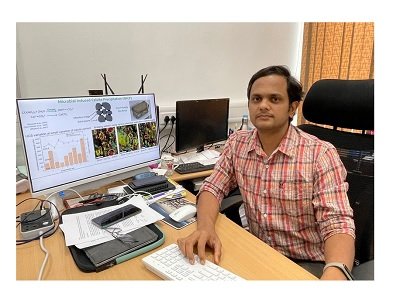IIT Mandi researchers develops natural polymeric microgels for sustainable agriculture
Polymeric microgels are engineered for the slow release of nitrogen (N) and phosphorus (P) fertilizers over an extended period to enhance crop nutrition.
A research team from the Indian Institute of Technology Mandi has achieved a significant breakthrough in sustainable agriculture with the development of natural polymer-based multifunctional smart microgels. These microgels are engineered for the slow release of nitrogen (N) and phosphorus (P) fertilisers over an extended period, presenting a promising solution to enhance crop nutrition while minimising environmental impact.
Modern agriculture heavily relies on fertilizer applications to meet the escalating food demand of a growing population. While fertilizers are essential for providing nutrients to plants and improving crop yields, their effectiveness is often compromised by factors such as gaseous volatilization and leaching. Consequently, excessive fertilizer application not only leads to high costs but also has adverse effects on the environment, including groundwater and soil contamination, as well as human health hazards. Therefore, developing technological alternatives that prolong fertilizer release is imperative to facilitate a shift towards sustainable agriculture practices.
The findings of this comprehensive research have been published in the prestigious journal ACS Applied Materials & Interfaces from American Chemical Society. The research work was led by Dr Garima Agrawal along with her team including Ankita Dhiman, Piyush Thaper and Dimpy Bhardwaj from School of Chemical Sciences, IIT Mandi. The research was funded by the Science and Engineering Research Board, Government of India and the Department of Science & Technology, Government of India.
Explaining the motive of the study, Dr Garima Agrawal, Assistant Professor, School of Chemical Sciences, IIT Mandi, said, “We have developed natural polymer-based multifunctional smart microgels for the slow release of urea over longer period. These microgels also act as a potential source of phosphorus for plants and are cost effective, biodegradable and environment friendly.”
Further Dr Agrawal added, “The microgel formulation is eco-friendly and biodegradable, as it is made with natural polymers. It can be applied by mixing it into the soil or by spraying it on plant leaves. Recent studies with maize plants have shown that our formulation greatly improves maize seed germination and overall plant growth compared to pure urea fertilizer. This sustained release of nitrogen and phosphorus fertilizers helps crops thrive while cutting down on fertilizer use.”
These findings pave the way for sustainable agriculture, offering a promising solution to optimise nutrient supply, enhance crop yields, and mitigate environmental challenges associated with traditional fertilisers.
Polymeric microgels are engineered for the slow


